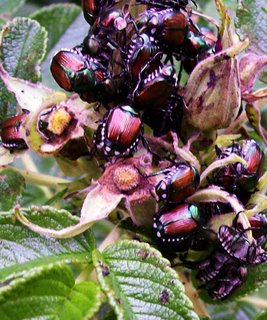 A hard rain has been falling since 4 this morning although it's been raining constantly since midnight. Gail won't have to worry about watering for a couple days. The rain in the wagons we have for customers to lug plants in is more than an inch deep. That's good!
A hard rain has been falling since 4 this morning although it's been raining constantly since midnight. Gail won't have to worry about watering for a couple days. The rain in the wagons we have for customers to lug plants in is more than an inch deep. That's good!It's been a wonderful year for the hosta because the spring warmed early and the rains were constant. Rain now is especially good for hostas because the next few weeks is when they expand their root systems. Larger roots converts to larger leaves and plants next year. If you live in an area which is not receiving good rain right now, water your hostas and you'll notice the difference next spring.
Peonies are another favorite of mine and I have over a hundred varieties growing in a nursery adjacent to the lower shade garden. It will be another September before I begin to dig and split them up but right now I'm pleaased with their growth. Peonies set buds for the following year in August in these parts. As with the hostas, provide supplemental water if you aren't receiving the rains we are. Although peony roots are fairly shallow in comparison to many other plants, give them a good soaking for the next few weeks. You'll be surprised next June and your neighbors will be asking for your secret.
This is the year for the Japanese Beetle here at Vermont Flower Farm. Actually it's true most everywhere. I'm embarrassed with the collection we have and it's all my fault to allow us to get back to this point. Years ago, probably 10-12 years ago now, I began using milky spore. It was expensive then and it is expensive now but it is worth the cost not to see scores of beetles as in the picture above. Milky spore is a bacterium specific to these beetles and it will eliminate all of them over time.
Admittedly you wonder how badly you've been beaten when you open a can for the first time, not knowing what to expect. It could be talcum powder or cornstarch and you wouldn't know any better as all you see is a fine white powder. Any time the soil temperature is above 50 degrees you spread the powder on your property. I tell folks to think of their land as a big piece of graph paper and drop an ever-so-small portion every four or five feet until the land is squared off. Before or after a rain would be great because the spores would start working right away.
As beetles contact the bacterium, they are doomed. Within a couple weeks they die and the bacterium has a chance to multiply from the corpses and expand to a larger region. Over time your property is covered and the beetles have been eliminated even though you can't see any of what is going on.
Modern day strains are supposed to be good for 20 years according to product info. I don't know that to be true as it seems that over time the "food" supply would be eliminated and the bacterium itself would die too. I am not a bacteriologist so I can't speak to that but I can say the stuff works fine once established. My problem is I forgot to reapply a couple years back and the beetle supply came back quickly.
Someone suggested to me that if I eliminated the plants that beetles feed on, I wouldn't have a problem. Another suggested I should buy beetle traps like she did and save money. All gardeners are free with their advice, at least I've never been charged for any and I have received a bunch. Japanese beetles feed on a variety of weeds I don't even want around here. I don't know many weed names but I do know that beetles do like some of them as much as they like roses (rugosa pictured above), grape vine and hollyhocks.
Beetle traps are one of the best American marketing schemes I have ever seen. They are inexpensive to manufacture--probably all made in China--and they fill with beetles within days. The lure in the trap is a potent sex attractor which will bring in the beetles from 3-4 miles away so naturally the bags will fill quickly. Since there are all kinds of beetles within a 4 mile radius of your home, a trap full of beetles might suggest a successful eradication program leading to more and more purchases and more and more bags full of Japanese beetles. Makes you think how many milllion beetles live in a four mile radius doesn't it? The moral of this story is save the money on the traps and buy milky spore. A 10 ounce can will treat 2500 square feet and costs about $28. It's probably cheaper on the Internet but you have to factor in postage. There are plenty of informative sites out there so if you have a problem with Japanese Beetles, give milky spore a try. Read up on the product first. I do not know if it will work if your lawns have been ruined with commercial insecticides in the past. Probably Master Gardeners or the Extension Service could answer that question.
Sunday gardening wishes, from the mountain above Peacham Pond, where a variety of daylilies still bloom in colorful glory. Come visit!
George Africa
http://vermontflowerfarm.com
No comments:
Post a Comment